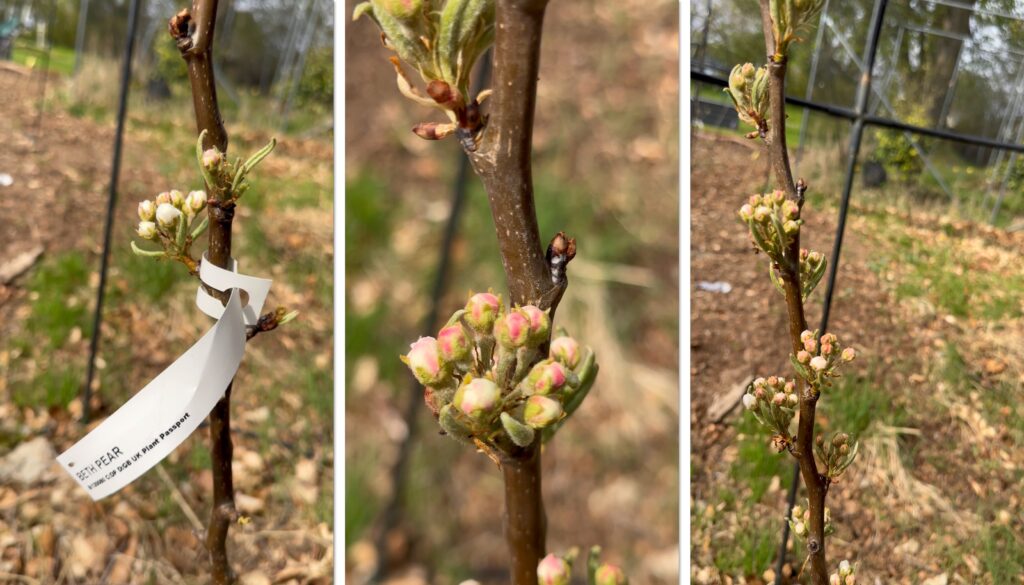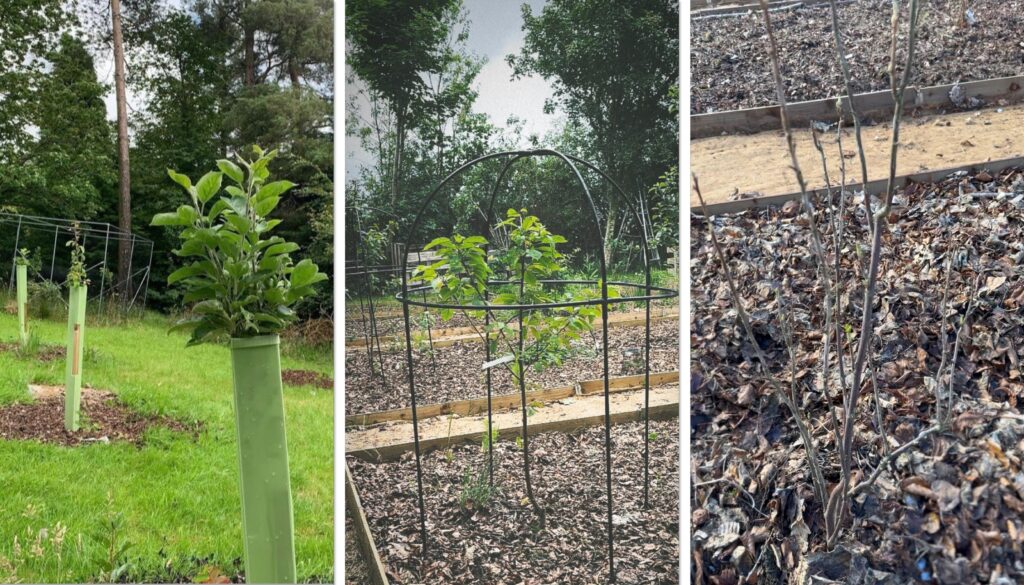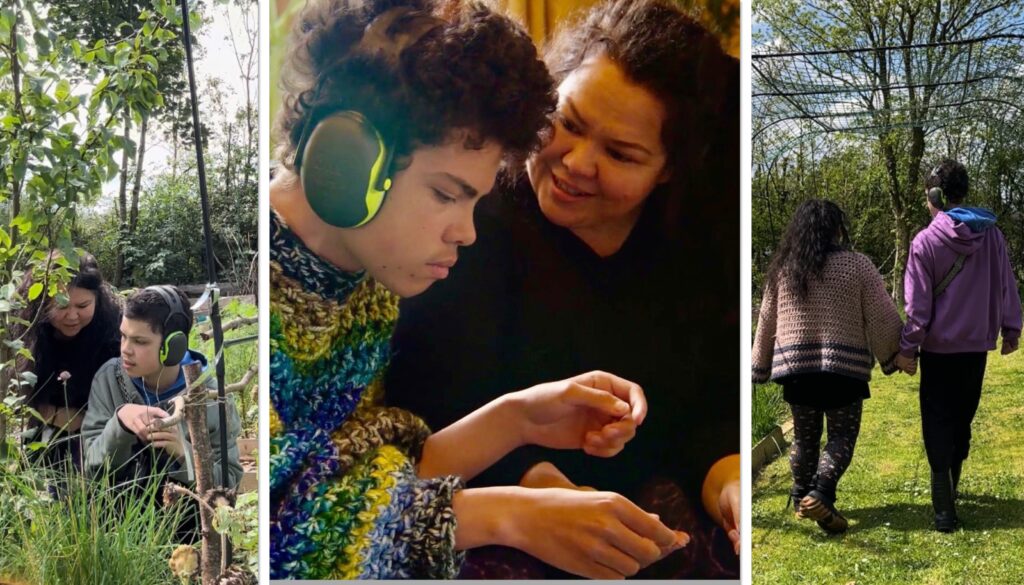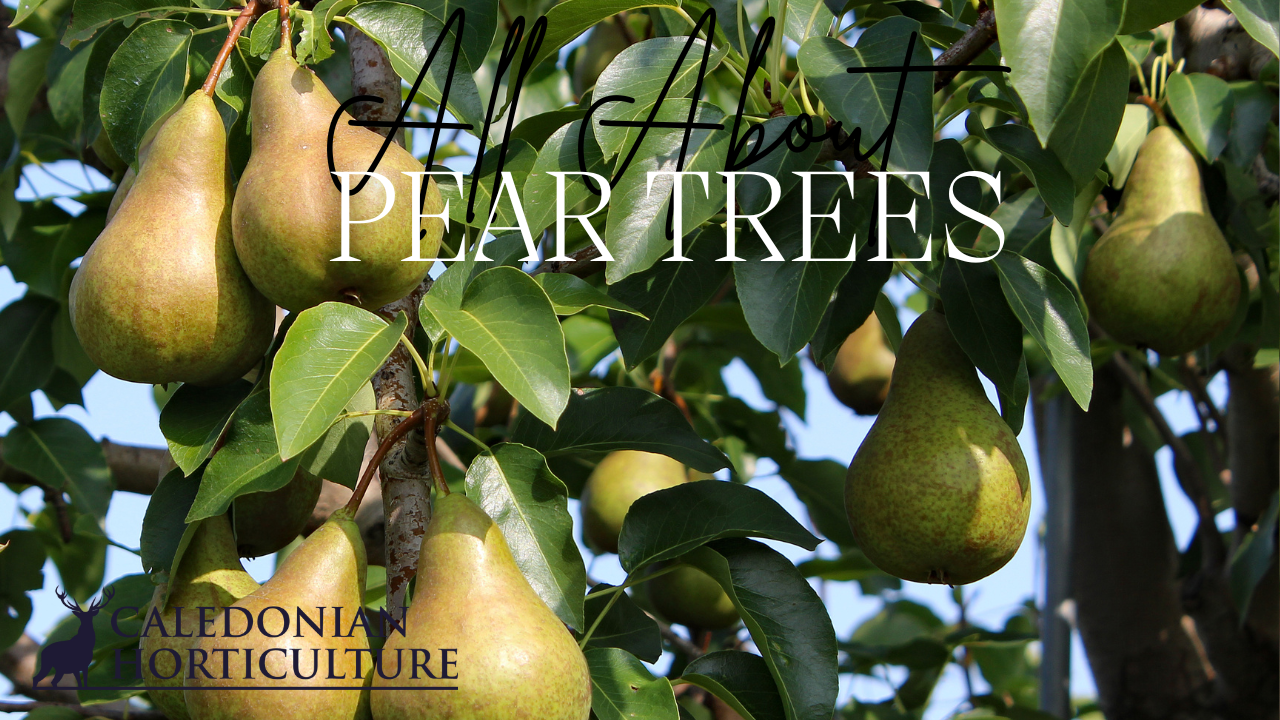Pear trees are a great addition to gardens in Scotland, providing delicious fruit and a touch of elegance with their seasonal blooms and graceful form. While the Scottish climate can present challenges, such as unpredictable weather and shorter growing seasons, careful planning and selection of the right varieties ensure success.
Growing Pear Trees in Scotland
Pear trees thrive in temperate climates, and many varieties are well suited to Scotland’s cool and damp conditions. When choosing pear varieties, opt for those known for their hardiness and ability to ripen in shorter growing seasons. Popular choices include:

Conference Pear (Pyrus communis ‘Conference’)
Reliable and self fertile, ideal for beginners.
The Conference pear is one of the most reliable and widely grown pear varieties in Scotland, thanks to its ability to withstand cooler temperatures and wet conditions. This self fertile variety thrives in the temperate Scottish climate, making it an excellent choice for home gardeners. It produces long, greenish yellow pears with russeted skin, and the fruit has a sweet, juicy flavor with a slightly grainy texture.
For optimal growth, Conference pear trees require a sunny, sheltered location to ensure proper fruit development. A south facing wall or fence can provide additional warmth and protection from strong Scottish winds. Well draining, fertile loamy soil with good organic content is ideal.
Pruning should be done in winter to shape the tree and remove any diseased or crossing branches. In spring, mulch around the base with compost or well-rotted manure to retain moisture and suppress weeds. While this variety is self fertile, planting another compatible pear variety nearby can increase yields through cross pollination.
Due to Scotland’s unpredictable weather, frost protection during the flowering period is beneficial. Covering the tree with horticultural fleece during unexpected late frosts can prevent damage to blossoms, ensuring a consistent annual crop of delicious pears.
Concorde Pear (Pyrus communis ‘Concorde’)
Hardy, sweet, and easy to grow.
The Concorde pear is another excellent choice for Scottish gardens, known for its disease resistance, compact growth habit, and reliable fruiting even in cooler climates. A cross between the Conference and Comice pears, the Concorde combines the best qualities of both: sweet, aromatic fruit with smooth, thin skin and a crisp yet juicy texture.
This pear variety thrives in sunny, sheltered spots and benefits from well draining, slightly acidic to neutral soil. In Scotland, where rainfall is frequent, raised beds or improved drainage can help prevent root rot. Like the Conference pear, the Concorde can self pollinate, making it a great standalone tree, though planting it alongside other pear varieties can enhance fruit production.
Minimal pruning is required, making it a low maintenance option for beginners. Light winter pruning helps maintain an open structure and encourages airflow to reduce fungal issues like scab and canker.
The Concorde’s hardiness makes it well suited to Scotland’s short growing season, as its fruit matures earlier than other varieties, allowing for a reliable harvest before autumn frosts arrive. This makes it a fantastic addition to any Scottish orchard or garden.
Beth Pear (Pyrus communis ‘Beth’)
Compact and suitable for smaller gardens, with excellent flavour.
The Beth pear is a compact, early fruiting variety that performs well in Scotland’s unpredictable climate. It is particularly suited to smaller gardens, as it does not grow as tall as other pear trees, making it easy to maintain. Its fruit is small to medium sized, with pale green skin that ripens to yellow, and the flesh is smooth, buttery, and exceptionally sweet.
Beth pears thrive in well drained, fertile soil with moderate moisture retention. A south facing location is ideal, as it helps the fruit ripen in Scotland’s cooler summers. While Beth is partially self fertile, planting it near Conference or Concorde pears can improve yields through cross pollination.
Due to its early flowering nature, Beth pears are more susceptible to late spring frosts, which can impact fruit production. To mitigate this, gardeners should consider planting in a sheltered spot or using fleece to protect blossoms on colder nights.Beth pears require annual pruning in late winter to remove any dead or overcrowded branches and encourage fruit bearing wood. As an early ripening variety, Beth provides some of the first pears of the season, typically ready to harvest from late August to early September, making it a valuable addition to Scottish gardens.

Planting Pear Trees
How & When to Plant
Plant pear trees in late autumn or early spring when the soil is workable but not waterlogged or frozen.
Site Preparation: Clear the planting site of weeds and enrich the soil with compost like Caledonian Kelpie Compost or Caledonian Green Goodness. Ensure good drainage, as pears dislike waterlogged roots.
Digging the Hole: Dig a hole twice the width of the tree’s root ball and slightly deeper than its height. Loosen the soil at the bottom to encourage root penetration.
Positioning the Tree: Place the tree in the hole so the graft union (a slight bulge near the base) sits above the soil level. This prevents it from growth from rooting.
Backfilling: Fill the hole with soil, pressing gently to remove air pockets. Water thoroughly to help the tree settle.
Support: Stake young pear trees with a sturdy support to protect them from strong Scottish winds, remove after a year to allow the tree to form strong roots to support itself from the winds.

They have been in 5yrs now and have yet to have fully matured fruit.
Pruning Pear Trees
Pruning is essential to maintain the shape, health, and productivity of pear trees.
How & When to Prune
Prune in late Winter or early Spring when the tree is dormant. Avoid pruning in frosty conditions to prevent damage. Summer pruning can also be done to remove excessive growth and encourage better air circulation.
Shape the Tree: In the first few years, aim to develop an open, goblet shape with a central framework of branches. This allows sunlight and air to penetrate the canopy.
Remove Dead Wood: Cut away any dead, diseased, or crossing branches.
Thin the Branches: Remove overcrowded growth to prevent shading and improve fruit production.
Maintain Size: Trim back overly vigorous shoots to keep the tree manageable and encourage balanced growth.
Caring for Pear Trees
Proper care ensures your pear trees remain healthy and productive for years.
Watering: Pear trees require consistent moisture, especially during dry spells. In Scotland’s wetter climate, ensure soil drains well to avoid waterlogging.
Pest and Disease Control: Common issues in Scotland include pear scab, aphids, and codling moths. Regularly inspect to manage pests and diseases. Remove fallen fruit and leaves to reduce the risk of fungal infections.
Protecting Blossoms: In Scotland’s unpredictable spring, frost can damage blossoms. Protect trees with fleece or position them in sheltered areas.
Companion Planting for Pear Trees
Companion planting enhances the health and productivity of pear trees by deterring pests, improving soil health, and attracting pollinators.
Beneficial Companions
Marigolds: Repel nematodes and aphids.
Chives and Garlic: Deter aphids and other pests with their strong scent.
Comfrey: Acts as a living mulch and enriches the soil with nutrients.
Wildflowers: Attract bees and other pollinators essential for fruiting.
Growing pear trees in the Scottish climate offers delicious fruit and an ornamental presence in the garden. By choosing hardy varieties, planting them in well prepared soil, and providing regular care, your pear trees can thrive even in Scotland’s challenging weather conditions.
Katrina & Clayton

Katrina & Clayton live with their family in East Ayrshire in Scotland and share their daily life in the garden on instagram @buildingfoodforest_scotland. They practice permaculture principles, reducing & repurposing waste whenever they can. Katrina shows how home educating in nature has helped Clayton thrive.
Clayton Completed The Grow and Learn Course with the Royal Caledonian Horticultural Society in 2022. This year he will be completing Level 2 Nurture Course. Clayton is 16, Autistic, Non Verbal & has been Home Educated for the last 6yrs. Both Katrina and husband Peter have studied the Permaculture Design Course PDC and PDC Pro over the last 5yrs, developing their garden from grass to an ongoing food forest.
They have featured on BBC Beechgrove Gardens, Gardeners World Magazine and write for Scotland Grows Magazine. Katrina has a series of children’s story books out following the life of Clayton in the garden. Available at Amazon.
See more and follow Katrina & Clayton at the links below:
-
 Builder’s Bag Planter Mix£79.00 inc VAT
Builder’s Bag Planter Mix£79.00 inc VAT -
 Builder’s Bag Kelpie Compost£72.00 inc VAT
Builder’s Bag Kelpie Compost£72.00 inc VAT -
 Builder’s Bag Green Goodness£52.00 inc VAT
Builder’s Bag Green Goodness£52.00 inc VAT

